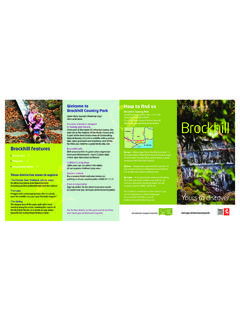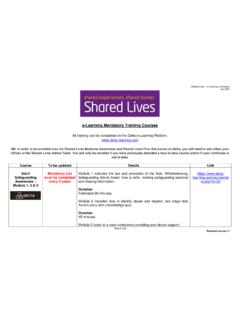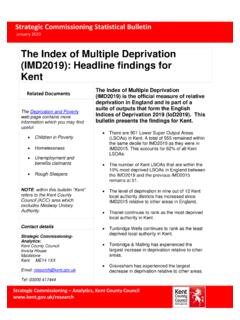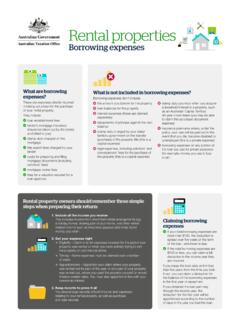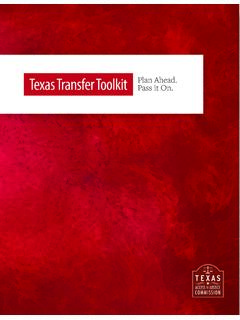Transcription of Financial Abuse Toolkit - Home - Kent County Council
1 Safeguarding Adults at Risk Financial Abuse Toolkit 2 Contents: Chapter Title Page(s) 1. Why do we need a Financial Abuse Toolkit ? 4 - 6 2. What is Financial Abuse ? 7 - 8 3. Why is recognising Financial Abuse important? 9 4. Recognising someone at risk of Financial Abuse 10 5. Who is likely to perpetrate Financial Abuse ? 11 6. How can you recognise if someone is experiencing Financial Abuse ? 12 7. Planning an investigation/making s42 enquiries into Financial Abuse 13 8. Responsibilities of practitioners 14 9. Who can help with what? 15 Appendices Appendices 16 Appendix A List of Internal Teams 17 - 22 Appendix B List of External Teams 23 - 27 Appendix C Seeking Legal Redress 28 - 30 Appendix D Strategies for Protecting Adults at risk of Financial Abuse 31 - 35 Appendix E Case studies providing some examples of Financial Abuse cases 36 - 64 3 4 1.
2 Why do we need a Financial Abuse Toolkit ? Reported incidents of Financial Abuse are on the increase, both nationally and locally. Increased awareness and better levels of reporting may explain the increase but research shows that much of this type of Abuse can go undetected for a variety of reasons. This document should be read in conjunction with the Multi-Agency Safeguarding Adults, Adult Protection Policy, Protocols and Guidance for Kent and Medway. Local context Kent has a population of 1,463,740 people, of which 185,519 are aged 70 or over1. There are over 19,500 people known to have a form of dementia, and also a large number of people residing in residential care settings. Given that 31% of properties in Kent have a single occupancy and 58% of recorded Financial Abuse cases occurred in people s homes; the risk of people susceptible to Abuse is increased.
3 This is illustrated by the pie charts below: 2 1 2011 Census data 2 KCC swift report Discriminatory 0% Emotional/Psychological 12% Financial 17% Institutional 1% Neglect 27% Physical 38% Sexual 5% Abuse by Type 2013/14 5 3 What is the purpose of the Toolkit ? While practitioners may be experienced in recognising adults at risk, they may lack the awareness and experience of certain types of Financial Abuse , especially more sophisticated forms of fraud. This can lead to people experiencing Financial Abuse not being provided with appropriate responses and safeguarding concerns not being raised. The Toolkit aims to provide practitioners with the information they need to respond appropriately to suspected cases of Financial Abuse . It will do this by: Highlighting how effective partnership working between departments, such as Internal Audit Counter Fraud Team, Trading Standards, Legal Services, Client Financial Affairs etc as well as external partners eg.
4 Kent Police, CQC and NHS Counter Fraud Service may create better outcomes for our clients and offer more robust investigatory actions. 3 KCC swift report Acute Hospital 2% Alleged Perpetrators home 1% Care home 13% Care home with Nursing 2% Community Hospital 1% Not Known 14% Day Centre 0% Other 4% Own home 58% Public Place 3% Supported Accommodation 2% Locations of Financial Abuse 2013/14 6 Providing case examples that demonstrate how Financial Abuse s42 enquiries can be conducted effectively. Providing information on additional resources for further reading and sharing with clients and partner agencies. Feedback Constructive feedback is welcome. Please email comments marked Financial Abuse Toolkit feedback to: 7 2. What is Financial Abuse ? Financial Abuse is: The unauthorised and improper use of funds, property or any resources belonging to another individual4 It includes: theft, fraud and exploitation, pressure in connection with wills, property, inheritance or Financial transactions, misuse or misappropriation of property, assets, possessions, savings, capital or benefits.
5 Types of Financial Abuse Financial Abuse may include: Theft money or possessions stolen, borrowed or withheld without permission. Wrongfully controlling access to money or benefits. Preventing someone buying goods, services or leisure activities. Money being absorbed into a care home or household budget without the person s consent. Being deliberately overcharged for goods or services, or being asked to part with money under false pretences. Not providing the care (1 to 1 and shared hours) but charging the client. Carrying out unnecessary work and / or overcharging. Postal, telephone and internet scams where the person has interacted with someone and has lost money. Unlicensed money lending ( loan sharks) being offered a loan on very bad terms. Staff or volunteers borrowing money, or accepting gifts or money from clients. Misuse of a person s assets by professionals.
6 4 DH / home Office, 2000 8 Altering ownership of property without consent. Exerting undue influence to give away assets. Pressure in connection with wills, property, inheritance, possessions or benefits. Putting undue pressure on the person to accept lower-cost / lower-quality services in order to preserve more Financial resources to be passed to beneficiaries on death. Misuse of powers of attorney. Types of Financial misuse, Abuse and fraud within the personal budget/direct payments system Financial misuse, Abuse and fraud within the personal budget/direct payment system may include: The client and/or their representative exaggerating the clients needs to increase their entitlement. (misuse of the process) The client and/or their representative not declaring all their income or capital to reduce their client contribution.
7 (misuse of the process) The client and/or their representative using the direct payment for items not covered in the care plan. (misuse of the process) The client and/or their representative not declaring a change in their Financial circumstances which would affect their client contribution. (misuse of the process) A care provider (or Personal Assistant) charging for care which has not been delivered. (adult Abuse and possible crime) Third party who has control of the direct payment not using the payment for the benefit of the client. (adult Abuse and fraud) 9 3. Why is recognising Financial Abuse important? The impact of Financial Abuse should not be underestimated and can be every bit as significant as physical Abuse . Even small losses have the potential for significant impact when considered in context with a person s overall wealth / income and whether or not they have access to the right support.
8 The negative impact of Financial Abuse , regardless of the source, can leave people unsettled and without the confidence to live independently. It can cause the person who previously did not have a need for social care services to deteriorate to the level at which they require services. How does Financial Abuse affect someone? A person may experience any of the following: Depression / anxiety Distress Anger Embarrassment / loss of self-esteem Self-blame decline in mental health Denial / fear Betrayal Stress Loss of confidence to live independently Deterioration in physical health (leading to premature death) Social isolation More vulnerable to further exploitation Inability to replace lost savings due to lack of earning potential 10 4. Recognising someone at risk of Financial Abuse Profile of an adult at risk of Financial Abuse An adult at risk of Financial Abuse is likely to display one or more of the following: The person is unable to manage their own finances due to lack of capacity or sufficient numeracy skills.
9 The person is dependent on another person or people to manage their money. The person is dependent on others for all aspects of daily living, such as those who live in residential care. The person is known to be isolated or is regarded as at risk within the community. A person who is isolated or lives on their own may be more at risk of being exposed to Financial pressure from salespersons, loan firms, rogue traders or bogus callers. The person is of a trusting or gullible nature. The person is susceptible to emotional grooming. For older people in particular, potentially increased assets coupled with low-cost lifestyles and a lack of awareness of the modern world may make them more susceptible. Note: Whilst a person who lacks capacity may be considered to be more at risk of Financial Abuse , it should be remembered that someone with capacity can be equally susceptible.
10 For example, it should not be assumed that if a person who has capacity makes a gift, then it cannot be regarded as theft. Coercion and undue influence, emotional grooming and predatory behaviours as well as the reasonableness of the transaction all need to be considered. 11 5. Who is likely to perpetrate Financial Abuse ? Financial Abuse is most frequently perpetrated by a person acting in a trusted capacity, for example, a family member or friends and neighbours or care workers / other professionals. Examples include: Staff in care establishments exploiting residents by gaining their trust and taking over their finances unlawfully. Care providers invoicing for services not provided. Powers of attorney exploiting their position by misappropriating funds. Some families may have a view that the income of individual family members, including benefits for disabled adults, should be pooled into the family income.

